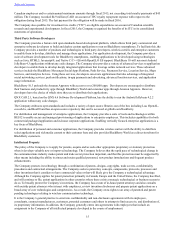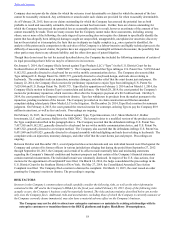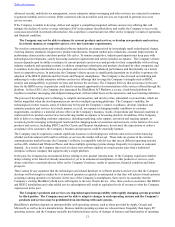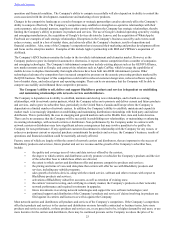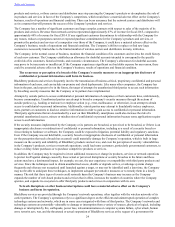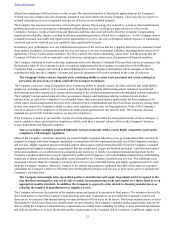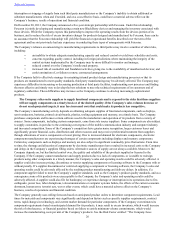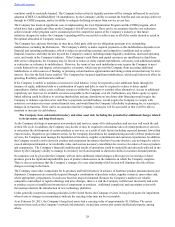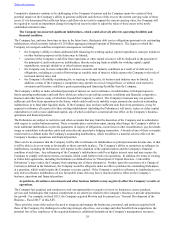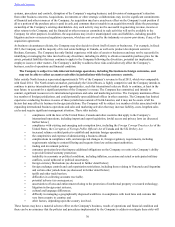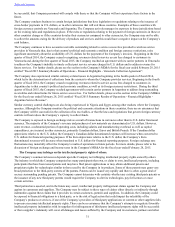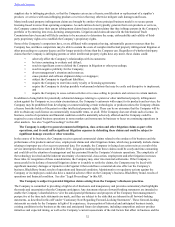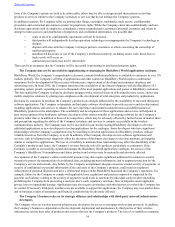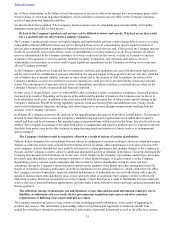Blackberry 2015 Annual Report Download - page 34
Download and view the complete annual report
Please find page 34 of the 2015 Blackberry annual report below. You can navigate through the pages in the report by either clicking on the pages listed below, or by using the keyword search tool below to find specific information within the annual report.
Table of Contents
25
alleged noncompliance with local laws or other events. The increased number of third party applications on the Company’s
network may also enhance the risk of network disruption and cyber attack risk for the Company. There may also be system or
network interruptions if new or upgraded systems are defective or not installed properly.
The Company has experienced network events in the past, and any future outage in a network or system or other unanticipated
problem that leads to an interruption or disruption of BlackBerry services, could have a material adverse effect on the
Company’s business, results of operations and financial condition, and could adversely affect the Company’s longstanding
reputation for reliability, thereby resulting in end users purchasing products offered by its competitors. As the Company moves
to handle increased data traffic and support more applications or services, the risk of disruption and the expense of maintaining
a resilient and secure network services capability may significantly increase.
In addition, poor performance in or any additional interruptions of the services that the Company delivers to its customers could
delay market acceptance of its products and services and expose it to costs or potential liabilities, including under service level
agreements (“SLAs”) with certain customers. The SLAs specify the events constituting “down time” and the actions that the
Company will take to rectify or respond to such down time, including in certain cases, the payment of financial penalties.
The Company continues to work to develop, implement and test its Business Continuity Plan and there can be no assurance that
the measures taken by the Company to date, or measures implemented by the Company in connection with its Business
Continuity Plan, to manage risks related to network disruptions or other business interruptions will be adequate or that the
redundancies built into the Company’s systems and network operations will work as planned in the event of a disaster.
The Company's future success depends on its continuing ability to attract new personnel and retain existing key
personnel, the loss of any of whom could adversely impact its business.
The Company’s success is largely dependent on its continuing ability to identify, attract, develop, motivate and retain skilled
employees, including members of its executive team. Competition for highly skilled management, technical, research and
development and other employees is intense and increasing in the wireless communications and embedded software industries.
The Company’s recent restructuring activities, governance changes, and challenges relating to delays in new product
introductions, as well as the Company's loss of market share, share price performance (particularly for those employees for
whom equity-based compensation has been a key element of their compensation) and perceived future prospects, among other
factors, may impact the Company’s ability to attract new employees and retain existing employees. None of the Company’s
executive officers or key employees is bound by an employment agreement for any specific term. The Company does not
maintain key-person life insurance policies on any of its employees.
If the Company is unable to successfully execute its current strategies and realize the anticipated benefits of those strategies, it
may be unable to attract and retain key employees, which could have a material adverse effect on the Company's business,
result of operations and financial condition.
Sales to customers in highly regulated industries and governmental entities can be highly competitive and require
compliance with stringent regulation.
Many of the Company’s enterprise customers are either in highly regulated industries or are governmental entities and may be
required to comply with more stringent regulations in connection with the implementation and use of the Company’s products
and services. Highly regulated and governmental entities often require contract terms that differ from the Company’s standard
arrangements and impose compliance requirements that are complicated, require preferential pricing or “most favoured nation”
terms and conditions, or are otherwise time-consuming and expensive to satisfy. Government demand and payment for the
Company’s products and services may be impacted by public sector budgetary cycles and funding authorizations, with funding
reductions or delays adversely affecting public sector demand for the Company’s products and services. The additional costs
associated with providing the Company’s products and services to governmental entities and highly regulated customers could
harm the Company’s margins. Moreover, changes in the underlying regulatory conditions that affect these types of customers
could harm the Company’s ability to efficiently provide BlackBerry products and services to them and to grow or maintain the
Company’s customer base.
The Company increasingly relies upon third parties to manufacture and repair its products and it is exposed to the
risk that these third parties may not be able to satisfy its manufacturing needs and repairs on a timely basis or to an
appropriate quality standard. In addition, the Company is exposed to risks related to changing manufacturers or
reducing the number of manufacturers or suppliers it uses.
The Company outsources the majority of the manufacturing and repair of its products to third parties. The resources devoted by
these third parties to meet the Company’s manufacturing and repair requirements are not within the Company’s control and
there can be no assurance that manufacturing or repair problems will not occur in the future. Third party manufacturers, or other
third parties to which such third party manufacturers in turn outsource the Company’s manufacturing requirements, may not be
able to satisfy the Company’s manufacturing requirements on a timely basis, including by failing to meet scheduled production
and delivery deadlines or to meet the product quality requirements of the Company and its customers. Insufficient supply or an


